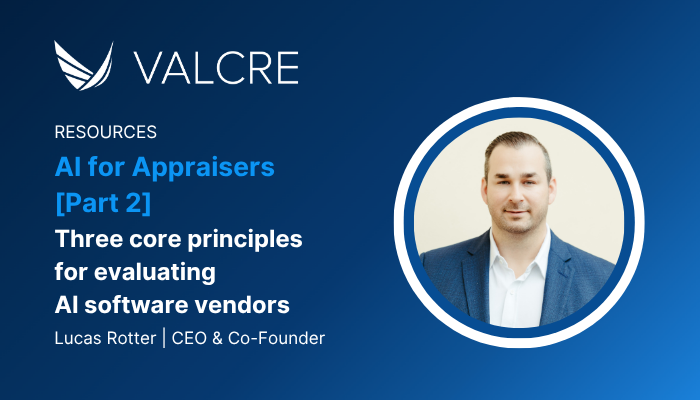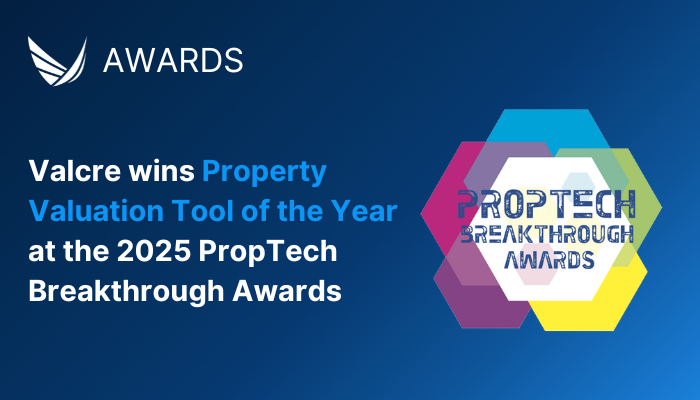
AI is coming hard and fast for the appraisal profession, and questions around the practical uses of AI and how to take the first steps into this new realm are top of mind across the board.
In the first part of this blog series, we looked at the various use cases of AI, both as it applies to general business operations and appraisal workflows more specifically.
In this next installment, we’ll explain how to think about selecting AI vendors, particularly in a world where new consultants and software providers are emerging quickly – and not all of them are trustworthy or credible.
3 core principles when selecting AI software vendors
At Valcre, there are three core values we hold when making AI decisions for our own business, and that we encourage our clients to consider as well. Potential vendors and solutions must be:
1. Agile
AI is evolving rapidly, Models are constantly being improved and replaced. You don’t want to be locked into outdated tech just months after launching.
Look for vendors who:
- Build systems with swappable models that are adaptable as new innovations are released.
- These models also need to be retrainable, with feedback mechanisms that learn and improve based on user engagement.
- Use modular models, garnering more accurate results with less hallucinations. This is optimal over a one-size fits all solution.
2. Accurate
This seems obvious, but it’s critical: AI should enhance your accuracy, not create new liabilities.
Key traits to look for:
- Human in the loop controls – Appraisers should always validate outputs. You don’t want an AI solution to come up with a valuation by itself with no validation. Appraisers are the experts and any model must include mechanisms to incorporate your input and expertise.
- Repeatability – Any calculation or AI output should be explainable and reproducible by a human. This is especially important when you consider the uses of appraisals in court scenarios. Appraisers need to be able to understand and defend the conclusion.
- Contextual intelligence – AI solutions need to be hyper-contextual to appraisal scenarios. As appraisers, we know how highly complex each step of the appraisal process is, especially with highly specialized scenarios. This necessitates not just one model, such as what ChatGPT would provide, but many small models that focus on one stage of the process and do it very well, and then stitch the end result (the valuation) together seamlessly. This approach means your team can build valuations asynchronously and make better decisions throughout the process.
Think of it like this: AI should augment your expertise, not replace it. The best tools act as smart assistants—not autonomous black boxes.
3. Trustworthy
The early days of AI are exciting – but they also come with real risks around data privacy and security. This means we’re also at the beginning of determining how secure AI can be. In this pioneering stage, partnering with trustworthy vendors who have the highest security and privacy safeguards in place is paramount.
Key factors to consider include:
- Data ownership should be a primary question as you consider vendors. When you input data into a solution, who owns it? How can you make sure it’s not winding up in the hands of a foreign government, or your competitors?
- Data residency is also critical, that is, where is your data housed? Is it onshore, offshore, or in third-party servers?
- What safeguards exist to prevent leakage, misuse, or unauthorized access?
Choose vendors that meet enterprise-level security standards and offer clear transparency around data handling and residency.
Choose vendors that have proven enterprise-grade standards with SOC 2 and ISO 27001 certifications. These certifications ensure the vendor is following industry best practices for security, privacy, and data handling.
Preparing your appraisal business to move forward with AI
With a solid understanding of what to look for in an external AI software provider, it’s now time to turn your attention inwards so that you can get your own house in order to leverage the advantages of AI.
The foundation for all AI success is your database. Without structured, accessible data, AI simply won’t work.
Why is this so critical? The way AI learns is similar to humans – by seeing, experiencing, and digesting information. The only way it can do that is through having access to real data.
Here’s what to prioritize:
- Organized, centralized data – Start by collecting the cleanest, most recent data you use day-to-day. And it’s not just raw data that’s important.
- Context-rich reports – AI learns like we do – by seeing examples. The more full-length reports it can analyze, the better it will understand how to generate accurate outputs.
- Text-based content – Especially for narrative generation, language models need paragraphs, not just tables. To create narratives for your appraisal reports, large language models (LLMs) predict strings of words to form sentences. It needs to ingest as much text and paragraphs of information, to learn how to draft the best outputs.
Building this foundational database and library of reports is often the first step where appraisal companies get tripped up and aren’t sure how to move forward. Common misgivings we’ve heard include teams that are either daunted by the undertaking of organizing years worth of data and not sure if it’s worth the effort, or teams that just aren’t sure how to even go about setting up a database in the first place.
The good news? You can start small – even if it’s just with the data you’re using for the appraisal project you’re working on today. Get it into a clean structured database as a first step. The important thing is that you start somewhere.
What’s next?
In the following installments of this series, we’ll walk through:
- How to build a foundational database to power AI and best practices for structuring your data *Coming soon*
- How to manage change across your team to ensure adoption and long term success *Coming soon*
At Valcre, we’re already working with leading appraisal teams to get their data AI-ready and future-proof their workflows. Want to see what’s possible? Get started with a demo.


![AI for Appraisers [Part 4]: Managing change for a successful AI rollout](https://www.valcre.com/wp-content/uploads/Blog-featured-image-–-AI-Content-Series-May-2025-8.png)